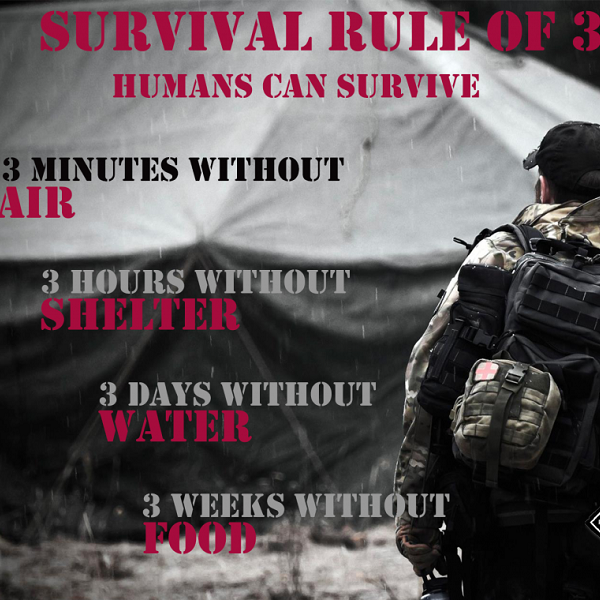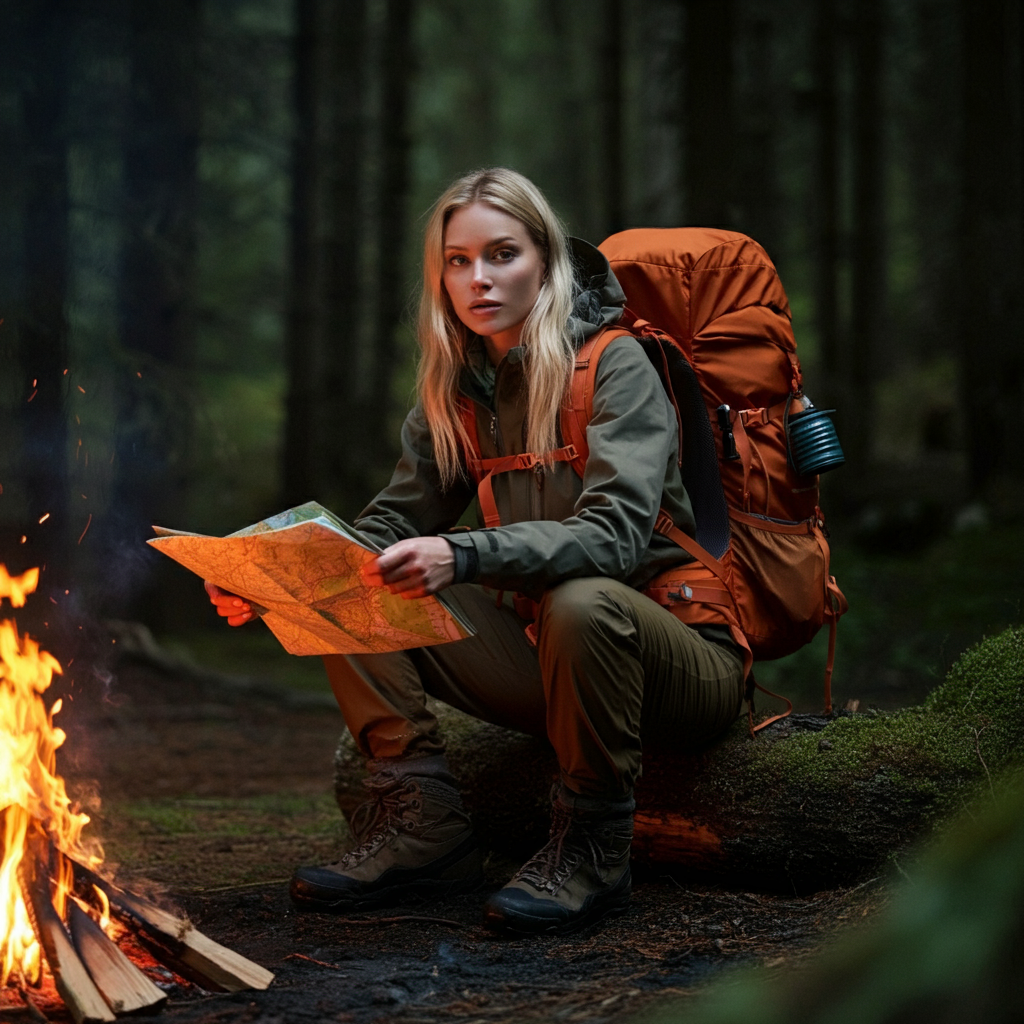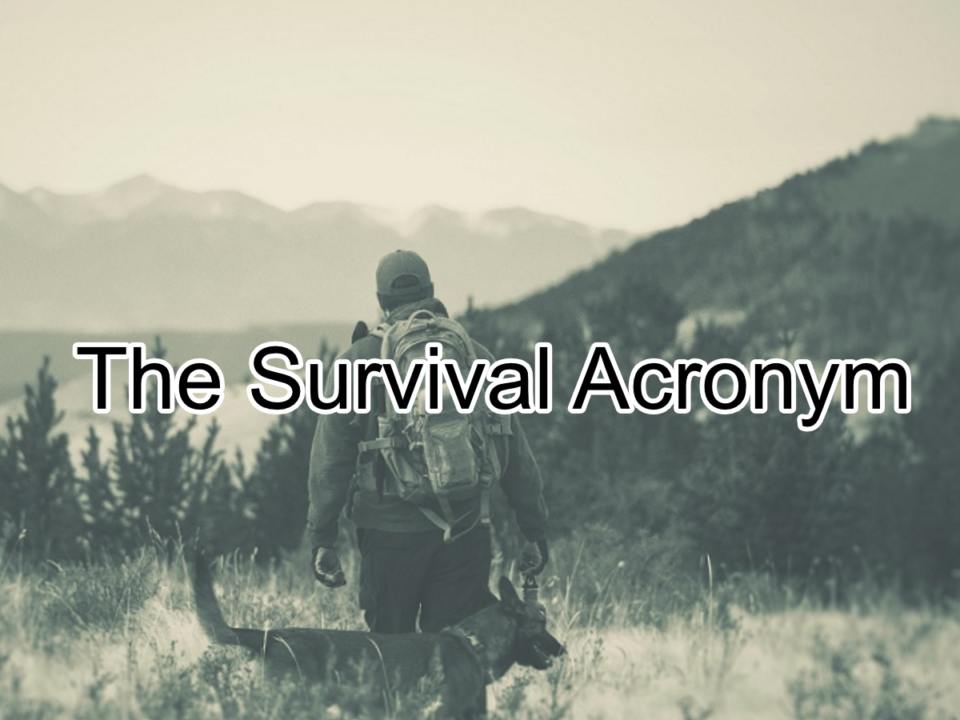Cart

The Rule of Threes: A Guide to Survival Priorities
When it comes to survival, there are four fundamental priorities you must address. These priorities, often referred to as the “Rule of Threes,” serve as a framework to help you prepare for emergencies and act effectively when disaster strikes. Their simplicity keeps you focused on what matters most to stay alive. Absent critical injuries, following these rules will give you the best chance of survival.

The four most commonly discussed rules of survival are 3 minutes without breathing, 3 hours without shelter in an extreme environment, 3 days without water, and 3 weeks without food. However, we believe that two additional rules; 3 seconds without hope and 3 months without human contact, are often overlooked but equally important. Below, we’ll explore all six rules and their critical role in survival.
In general, the human can survive for:
- 3 seconds without hope (survival mindset)
- 3 minutes without breathing (asphyxiation, severe blood loss)
- 3 hours without shelter in an extreme environment (exposure)
- 3 days without water (dehydration)
- 3 weeks without food (starvation)
- 3 months without human contact (the need for connection)
The Survival Mindset (Three Seconds)
Survival isn’t just about skills or gear, it starts in your mind. In a survival situation, your mental fortitude determines whether you’ll persevere or succumb to fear and doubt. A person can only survive 3 seconds without hope because once negativity takes hold, failure is almost inevitable. Maintaining a positive mindset, even in the face of overwhelming odds, is critical for making sound decisions and taking action.
Why the Right Mindset Matters
Survival situations are inherently stressful, triggering your fight-or-flight response. This stress can cloud your judgment, drain your energy, and lead to fatal mistakes if you don’t control it. Mental preparedness allows you to stay calm, assess your situation rationally, and prioritize your actions.
How to Develop Mental Toughness
The best way to build resilience is by training in controlled, challenging environments. Forcing yourself out of your comfort zone. Through survival courses, extended time outdoors, or deliberate exposure to stress, bolsters your ability to manage fear and uncertainty. This kind of training conditions your mind to see adversity as a problem to solve, not an insurmountable obstacle.
The Power of Positivity
Hope isn’t just a feel-good concept; it’s a survival tool. Focusing on small victories, like successfully building a fire or finding water, keeps your mind engaged and focused on progress. Setting achievable goals, practicing gratitude, and visualizing success can all help maintain a strong mindset in the wild.
Asphyxiation and Severe Blood Loss (Three Minutes)
Lack of oxygen or severe blood loss is the most immediate threat to survival, leaving you only moments to act. Fires, for example, are one of the most common causes of asphyxiation in daily life. Preparing for a house fire is important: develop an escape plan, especially if you have children, and install smoke detectors and fire extinguishers throughout your home. Practice your escape route regularly, and try navigating it blindfolded to simulate low-visibility conditions.
If you’re a serious prepper, you might also consider gas masks. While they’re often associated with biochemical threats, they’re equally effective in protecting against smoke inhalation. During the Colorado Springs Waldo Canyon Fire, knowing my family had gas masks was a huge comfort, ensuring we could breathe even in the worst conditions.
Carbon monoxide poisoning is another silent but deadly risk. Be sure to install carbon monoxide detectors in your home. If you’re stranded in a car during a snowstorm, crack the windows slightly for ventilation, and make sure the tailpipe stays clear of snow or debris. Conserve fuel by running the car only as needed.
Poisonous fumes from chemicals are another danger, especially near tanker trucks, industrial sites, or chemical storage areas. Such fumes can render you unconscious—or worse—in seconds. Always approach cautiously and assess the situation before attempting to help others. If fumes are visible or suspected, proceed with extreme care, especially in enclosed spaces or low-lying areas where gases may accumulate.
Smothering and oxygen deprivation can occur in natural disasters like avalanches, mudslides, or earthquakes. Avoid placing yourself in such scenarios whenever possible. If you’re caught in an earthquake, try to get outside or find a structurally safe area. Around water, practice caution—flash floods, tsunamis, or falling through ice are all potential asphyxiation hazards. Always know your evacuation routes and use appropriate safety gear.
Severe blood loss is equally urgent. Practice first aid skills, such as applying pressure to wounds and using tourniquets. Equip your first aid kit with items like QuikClot or Blood Stop pads to help manage heavy bleeding.
Finally, don’t underestimate the risk of shock, which can be life-threatening if left untreated. Keep yourself or the injured person warm, calm, and still. Cover them with a blanket, elevate their legs, and check for breathing regularly if they’re unconscious.
Shelter: Exposure to the Elements (Three Hours)
Exposure to extreme weather—whether from cold, heat, or wet conditions—is the next greatest threat to survival. Without proper shelter, you can lose the ability to function in just a few hours. The question is: do you have the tools and knowledge to protect yourself when you’re away from home?
Even in urban environments, exposure is a real danger. Imagine sliding off the road in a blizzard or getting caught outside during a heatwave. Preparation is key. A compact Everyday Carry (EDC) survival kit can help you face these risks. EDC items like a Mylar blanket, waterproof matches, and a flashlight can fit in your pocket or bag. For longer trips, keep a larger kit in your vehicle, as being stranded in your car is one of the most common emergency scenarios.
Knowing how to build an improvised shelter with natural materials is another vital skill. Take the time to practice setting up tarps or constructing basic shelters before you need them. A small investment in preparation can save your life.
Water: Dehydration (Three Days)
After oxygen and shelter, water becomes your next priority. Dehydration can impair your mental and physical abilities long before three days are up, especially in extreme heat or during physical exertion.
In temperate climates, the human body needs about 2.5 liters of water per day. In hotter conditions, or if you’re experiencing diarrhea, your needs will increase significantly. Carrying large amounts of water isn’t always practical, so knowing how to find and purify it in the wild is invaluable. Portable filters, water purification tablets, or an understanding of natural filtration methods can make all the difference
If water is scarce, conserve your energy. Travel during the cooler hours of the night, rest during the day, and avoid eating if you have no water, as digestion increases your need for hydration. Never ration water, drink as much as you need to maintain function. Learning how to locate and purify water is a skill every survivalist should master.
Food: Starvation (Three Weeks)
Food, while still a survival priority, is the least urgent of the Rule of Threes. It takes time to starve to death, but lack of food will eventually sap your energy and morale. Knowing how to find or hunt food in a survival situation can help you stay strong and focused.
Foraging for edible plants, hunting small game, or even eating insects might be necessary to survive. It may not be appetizing, but when survival is at stake, you’ll need to adapt. Practice these skills in advance to ensure you can rely on them when needed.
Personal factors can also affect how quickly hunger impacts you. For me, as someone with a slender build, I tend to crash quickly if I don’t eat while exerting energy. While I don’t need large amounts of food, I know I’ll be eating whatever I can find in an emergency.
Human Contact: Social Isolation (Three Months)
Humans are inherently social creatures. While many of us dream of solitude in the wilderness, the truth is that prolonged isolation can take a significant toll on our mental health. A person can survive 3 months without human contact before the effects of loneliness start to unravel their sense of reality. Without social interaction, our minds struggle to stay grounded, and the isolation can lead to a slow descent into madness.
Why We Need Human Interaction
Social bonds are hardwired into our biology. They provide emotional support, shared purpose, and a sense of belonging. In survival scenarios, even minimal interaction can make a difference by boosting morale and reducing the psychological burden of solitude. Without this connection, feelings of despair and loneliness can escalate, impairing judgment and leading to poor decision-making.
The Danger of Isolation
Extended isolation can cause issues like:
-
Cognitive Decline: Lack of interaction can dull problem-solving skills and critical thinking.
-
Emotional Instability: Feelings of loneliness can lead to anxiety, depression, or even hallucinations.
-
Loss of Motivation: Without social support, it’s harder to maintain the drive needed to survive.
Coping with Isolation
If human contact isn’t an option, finding ways to simulate connection is vital. Talking to yourself (yes, it helps), keeping a journal, or even imagining conversations can help keep your mind active and engaged. Building a relationship with your environment, observing wildlife, naming landmarks, or focusing on tasks, can also help stave off the psychological effects of loneliness.
Assess Your Situation
Survival is about staying aware, prioritizing your needs, and taking action. Begin by assessing your immediate situation with these questions:
-
Do I have the mental fortitude to focus and take action? (3 Seconds Without Hope)
-
Can I breathe safely, and am I bleeding? (3 Minutes Without Air or Severe Bleeding)
-
Do I have shelter to protect me from the elements? (3 Hours Without Shelter)
-
Where can I find water, and how can I purify it? (3 Days Without Water)
-
Once the basics are covered, what food sources are available? (3 Weeks Without Food)
-
How can I maintain a connection to others or preserve my mental health? (3 Months Without Human Contact)
By addressing these questions in order of urgency, you can stay calm, focused, and methodical even in the most stressful situations. Training in these principles and building familiarity with survival techniques helps ensure you can act decisively when it matters most.
Final Thoughts
The Rule of Threes is a powerful framework for survival, guiding your actions and priorities in emergencies. It underscores the need for preparation, adaptability, and a strong mindset. From the immediate need for air to the long-term importance of human connection, each “rule” highlights the balance between physical necessities and mental resilience.
Survival isn’t just about what you carry, it’s about how you think, adapt, and act. Prepare today by learning the skills and building the mindset that will help you face tomorrow’s challenges with confidence.
Leave a Comment
The Psychological Edge: How Overcoming Fear in Survival Situations Shapes You for Life
This post explores how facing fear in survival situations at The Survival University builds mental resilience and confidence that carry into everyday life. Through experiences...
THE SURVIVAL ACRONYM
Learn the Survival Acronym to navigate through difficult situations effectively. Size up, use your senses, vanquish fear, improvise, value life, and more.
The Rule of Threes
Learn the Rule of Threes for survival: prioritize breathing, shelter, water, and food. Prepare for emergencies with tips on safety and resourcefulness.


